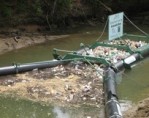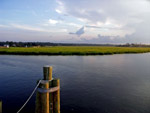
Fort Eustis, Va., uses its railroad systm to train soliders on train operations.

Group's annual report also features endangered river success stories from the past 20 years.
The Pesticides General Permit would require operators to use the lowest effective amount of pesticide, prevent leaks and spills, calibrate equipment and look for and report adverse incidents.
These projects will restore habitats, rehabilitate landfills, clean and store stormwater, lower the urban heat island effect, create outdoor educational opportunities at schools and reconnect neighborhoods to parks and public transportation.
The Smart Growth Leadership Institute will work with the state to align its land use and water protection programs.
State also has trained responders ready if the affected states should ask for assistance.
The technology turns a maintenance problem at the Nansemond plant into a commercially viable fertilizer product with no additional cost to the Hampton Roads Sanitation District.
The National Oceanic and Atmospheric Administration contracted C&C Technologies to conduct a magnetometer survey of a proposed alternate anchorage site near the mouth of the Mississippi River, where ships can wait until their hulls are inspected.
Research provides insight into conditions needed to produce nitrogen fixation.

City takes out ARRA-funded loan to help stop trash from polluting the Satilla River.
The City Council and voters appear to support a restoration project that would dedicate half of 1,436 acres for recreation and the other half for a walkable, transit-oriented community.
U.S. District Court judge orders company to serve three years of probation and implement an environmental compliance plan.

Data of unaffected waters is critical to measuring ecological impact of Deepwater Horizon BP oil spill; agency also determines fishery disaster for Louisiana, Mississippi, and Alabama.
Normal reproductive cycling was disrupted by atrazine and fish did not spawn as much or as well when exposed to atrazine.

Indiana University scientists measured nitrogen and phosphorus retention as well as carbon sequestration in tidal soils of three Georgia rivers.
Company says it doesn't have enough information on alternative dispersants nor are sufficient quantities currently available.
USDA veterinarian warns that boating and fishing enthusiasts should still be vigilant in removing any potential threats from their equipment.